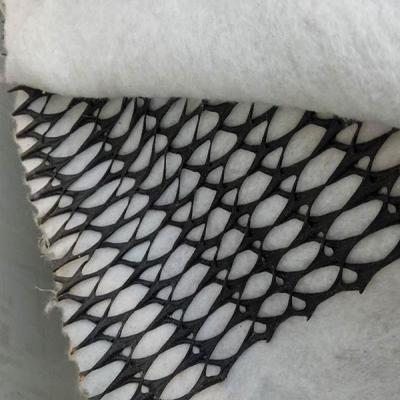1. Composition of composite drainage network
The composite drainage mesh is compounded by two or more layers of drainage mesh core and geotextile. The drainage mesh core is generally made of high density polyethylene ( HDPE) As raw materials, the drainage channel with three-dimensional structure is formed by extrusion molding through a special process. Geotextile acts as a filter layer to prevent soil particles from passing through and protect the drainage mesh core.
2. The difference between short filament cloth and long filament cloth
In the field of geotextiles, short filament cloth and long filament cloth are two common material types. Short silk cloth is made of polyester staple fiber needle punch, which has very good air permeability and water permeability, but its strength and durability are relatively low. The filament cloth is made of polyester filament spunbond, which has high strength and durability, and very good filtration performance.
3. Demand for geotextiles in composite drainage networks
Composite drainage network mainly undertakes the dual tasks of drainage and reinforcement in the project. Therefore, there are strict requirements for the selection of geotextiles. On the one hand, geotextile must have very good filtration performance, which can prevent soil particles from passing through and prevent the drainage mesh core from being clogged. On the other hand, geotextiles should have high strength and durability, and be able to withstand loads and long-term use in engineering.

4. Application of short filament cloth and long filament cloth in composite drainage net
1、In practical application, the choice of geotextile for composite drainage network often depends on the specific needs and conditions of the project. For projects that require higher strength and durability, such as heavy-duty traffic projects such as highways and railways, as well as projects that need to bear long-term loads and harsh environments such as landfills and water conservancy dikes, filament cloth is generally used as the filter layer of composite drainage networks. Because filament cloth has high strength and durability, it can better meet the needs of these projects.
2、For some projects that do not require high strength, such as general roads, green belts, etc., short silk cloth can also be used as the filter layer of composite drainage networks. Although the strength and durability of short silk cloth are relatively low, it has good air permeability and water permeability, which can meet the drainage needs of these projects.
5. Advantages of choosing filament cloth
Although short filament cloth has certain applications in some projects, long filament cloth is more widely used in composite drainage net. Mainly because the filament cloth has higher strength and durability, and can better withstand the loads and long-term use in the project. The filament cloth also has better filtration performance, which can prevent soil particles from passing through and prevent the drainage mesh core from being clogged. Filament cloth also has good corrosion resistance and anti-aging properties, and can be used in harsh environments for a long time without failure.
From the above, it can be seen that the type of geotextile used in the project for composite drainage network depends on the specific needs and conditions of the project. Although short filament cloth has certain applications in some projects, long filament cloth is more widely used in composite drainage nets because of its higher strength, durability and excellent filtration performance.
Post time: Mar-21-2025



